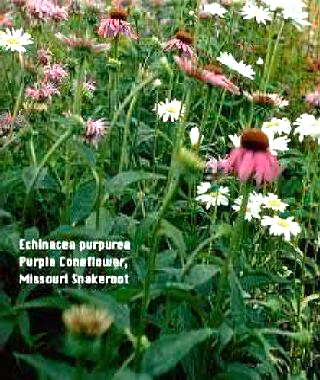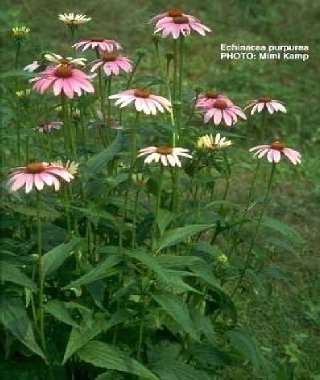

What is Echinacea? This section is compiled by Frank M. Painter, D.C.
Send all comments or additions to: Frankp@chiro.org




Thanks to the University of North Carolina School of Pharmacy for the use of this article!
Andrea Jones and Arlen Rash


Common Names:
- Purple cone flower
- Purple Kansas cone flower
- Black Samson
- Comb flower
- Missouri Snake Root
Echinacea Species:
- Echinacea purpurea
- Echinacea angustifolia
- Echinacea pallida
- Echinacea paradoxa
- Echinacea simulata
- Echinacea atrorubens
- Echinacea sanguinea
- Echinacea leevigata
- Echinacea tennesseensis
Location and Plant Description:
Native to Midwestern United States from Saskatchewan to Texas. The petals of the plant either droop toward the stem or spread outward from the stem. Typically 2 - 5 feet in height depending on the species.
Echinacea Purpurea: Usual height is 5 feet and it has large flowers with petals drooping toward the stem. The plant grows in rocky open woods and it is found in NE Texas, Missouri, and Michigan.Echinacea Pallida: The usual height is 3 feet and it has large flowers with petals drooping toward the stem. The plant grows on rocky open sites from NE Texas to SW Wisconsin.Echinacea Angustifolia: The usual height is 2 feet and it is a smaller more delicate plant with petals that spread out from the stem and do not droop. The plant grows on dry uplands from the Rocky Mountains from Texas to Montana and Saskatchewan to eastern Oklahoma.
Planting and Harvesting:
Planting usually occurs from October to March. It takes at least 3 years for the root to mature. Harvesting occurs from October to November when flowering has ceased. Parts that possess medicinal value are the rhizome and root.
Chemical Composition:
Active Components:
-polysaccharides, flavonoids, caffeic acid derivatives, akylamines, essential oils, polyacetylenesOther Components:
-resins, glycoproteins sterols, minerals, fatty acids
History and Folk Use:
Great Plains Native Americans
-Uses: sore mouth and gums, coughs, dyspepsia, colic, colds, bowels, tonsillitis, gonorrhea, fitsH.C.F. Meyer
-Physician from Pawnee, Nebraska introduced Echinacea as "Meyer's Blood Purifier." He claimed it was useful for treating: rheumatism, migraine, sore eyes, strep infections, wounds, tumors, eczema, dizziness, rattlesnake bites, gangrene, malaria, and bee stings.John King and John Uri Lloyd introduced Echinacea to the medical profession in1887.
Echinacea was part of the National Formulary from 1916-1950.
Pharmacology:
Immunostimulatory effects:
- Inulin: activates the alternative complement pathway by increasing granulocyte and leukocyte counts. It promotes chemotaxis of monocytes and neutralizes viruses and causes bacteriolysis.
- Polysaccharide: binds to carbohydrate receptors on the surface of T-lymphocytes and macrophages to produce immunostimulatory effects. They also enhance macrophage phagocytosis and stimulate macrophages to produce increased amounts of tumor necrosis factor, interferon and interleukin 1. It also destroys tumor cells.
- Alkylamines and caffeic acid derivatives: lipophilic alkylamines enhance macrophage phagocytosis.
- Echinacea: promotes non-specific T-cell activation, production of interferon and secretion of lymphokines. Shown to lower T-helper cells and decrease the T-helper:suppressor cell ratio
Other important pharmacologic effects:
- Tissue regeneration and anti-inflammatory properties:
- Echinacea and polysaccharide inhibits hyaluronidase
- Echinacea stimulates fibroblast growth and manufacture of glucosaminoglycans
- Exerts cortisone-like effects and enhances secretion of adrenal cortex hormones
- Polysaccharide appears to be responsible for anti-inflammatory effects
- Antibacterial properties:
- Mild antibacterial action due to echinacoside and caffeic acid derivative
- Antiviral properties:
- Echinacea inhibits influenza, herpes and vesicular stomatitis viruses
- Antiviral activity due to hyaluronidase inhibition
- May block viral receptors on the cell surface
Clinical Applications:
- Infections: influenza, colds, urogential infections, upper respiratory infections
- Arthritis
- Wound healing: treatment of abscesses, folliculitis, herpes
- Snake bites
- Cancer
Toxicity:
- No apparent danger from acute or chronic use.
- Low-grade fever may result if given IV.
Drug/Disease Interactions:
- No known drug interactions and no known disease interactions.
Dosage and Dosage Forms Available (TID dosing):
- Dried root (or as tea) 0.5-1g
- Freeze-dried plant 325-650mg
- Juice of aerial portion of E. purpurea 1-2ml
- Tincture 2-4ml
- Fluid extract 1-2ml
- Solid extract 100-250mg
Long-Term Use:
- Appears to be a period of initial stimulation (1-7 days) followed by a period of immune unresponsiveness (usually past 11 days).
- Usually only prescribed for 10 days followed by 2 weeks of rest.
Cost:
- Extra strength tincture (50-100ml): $9.50-18.50
- Echinacea tea (65g): $3.75-4.00
Clinical Trials
Infection
Treatment of Recurrent Candidiasis with Echinacin: Rate of Recurrence at 6 Months (Coeuginet and Kuhnast 1986)
Results:
Therapeutic Scheme: # of Patients Recurrence Rate (%)
Top. Econazole alone 43 60.5
Top. Ezole + SQ Echinacin 20 15
Top. Ezole + IM Echinacin 60 5
Top. Ezole + IV Echinacin 20 15
Top. Ezole + PO Echinacin 60 16.7
The study demonstrated that Echinacin increased the efficacy of econazole and decreased the recurrence rate of infection at 6 months. They used standardized skin tests to show that the enhancement was due to Echinacea's boosting of cell-mediated immunity.
Upper Respiratory Tract Infection
Upper Respiratory Tract Infection (Schoneberger 1992)
The effect of Echinacin on chronic upper respiratory tract infection was studied in 108 human volunteers with 3 or more occurrences of otitis, rhinitis, tonsillitis, pharyngitis, laryngitis, bronchitis, pneumonia, and sinusitis in a half year. The patients were given about 2x4ml/day of echinacin for 8 weeks.
Results: When Echinacin was compared to the placebo group, 36% fewer patient suffered from infections in the Echinacin group. Also the severity of symptoms were lessened, the time between infection was lengthened, and duration of infection was shortened.
References
Burton Goldberg Group. Alternative Medicine: The Definitive Guide. Washington: Future Medicine Publishing, Inc. 1994. Pg 263.
Hobbs C. "Echinacea: A Literature Review Botany, History, Chemistry, Pharmacology, Toxicology, and Clinical Uses." HerbalGram: 30: 33-47, 1994.
Marti J and A Hine. The Alternative Health and Medicine Encyclopedia. Detroit, MI: Gale Research, Inc. 1995. Pgs 90-91.
Mills SY. Out of the Earth: The Essential Book of Herbal Medicine. New York: Penguin Books. 1991. Pgs 487-491.
Murray MT. The Healing Power of Herbs. Rocklin, CA: Prima Publishing. 1996. Pgs 92-105.
Pissordno JE and MT Murray. A Textbook of Natural Medicine: Echinacea. Bothell, WA: Bastyr University Publications, Vol. 1, 1996.
Tyler VE. Herbs of Choice: The Therapeutic Uses of Phytomedicinals. New York: Pharmaceutical Products Press, 1994. Pgs 182-184.
Web Sites:
http://www.sunsite.unc.edu/london/herb.../inal/plants/echinacea_angustifolia
http://www.mothernature.com/Library/Ency/Index.cfm?id=2081004
http://www.islandnet.com/~eclectic/price.html
http://www.herbsinfo.com/pages/echin.htm
http://www.viable-herbal.com/1echinac.htm
http://www.kcweb.com/herb/echin.htm
http://www.herbsinfo.com/pages/pechinac.htm

Return to ECHINACEA


| Home Page | Visit Our Sponsors | Become a Sponsor |
Please read our DISCLAIMER |
